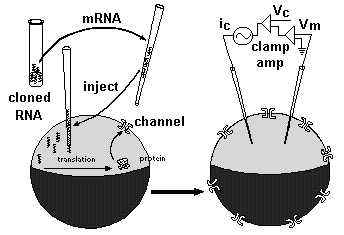
| Figure 1. |
 |
| Schematic of oocyte expression system and voltage-clamp recording method. Left: RNA (or DNA, not shown) prepared from a cloned gene for a membrane channel is injected from a micropipette into a frog oocyte. The oocyte contains the necessary processing systems to translate this RNA (or DNA) into the specific protein, which is then incorporated into the outer membrane of the oocyte as a functional channel. Right: Voltage-clamp recording is used to examine the properties of this newly expressed channel. The large size of the oocyte allows two-electrode voltage clamp. The recording pipette transmits the membrane potential (Vm) to the clamp amplifier, which also receives a voltage command (Vc). The comparative difference between Vm and Vc is used to generate a clamping current (Ic) which is injected into the cell to bring Vm to equal Vc. In this way, Vm is "clamped" to the value of Vc; the Ic needed to maintain this Vm is equal to currents flowing across the membrane at any time-point and can be examined as a function of drug application or changes in Vc, or small changes in the composition of cloned RNA/DNA (and therefore the channel protein). These manipulations can help isolate the parts of the inserted channel responsible for each unique property of that channel (e.g., sites for antagonist or G-protein binding). |
published 2000